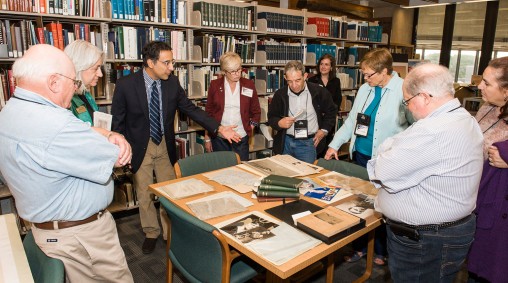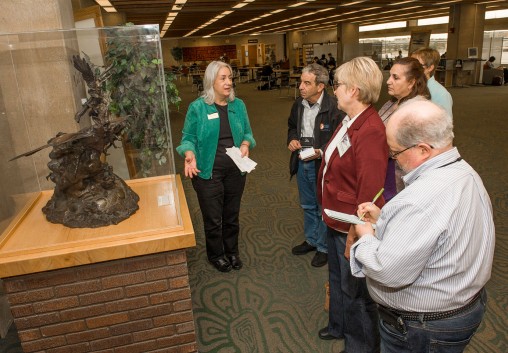
Archivist Gino Pasi discussing an item from Wright State’s Special Collections and Archives during a tour of the archives by prominent aviation writers. (Photo by Erin Pence)
Wright State’s Special Collections and Archives showed off its aviation history materials, including the world-class Wright Brothers Collection, when a group of prominent aviation writers toured the archives.
The writers toured the archives Oct. 1 as part of the National Aviation Heritage Alliance Aviation Writers Summit Presented by Dayton International Airport. The National Aviation Heritage Alliance is a nonprofit organization that promotes aviation history within the eight-county National Aviation Heritage Area around Dayton.
A dozen people from premier aviation magazines and associations attended the summit. It included visits to the National Museum of United States Air Force, National Aviation Hall of Fame, Huffman Prairie Flying Field, where the Wright brothers perfected their airplane design, and the Wright Company Factory.
Dawne Dewey, head of Special Collections and Archives, said exposing the writers to the Wright State’s archives and Dayton’s rich aviation legacy will promote interest, tourism and more efforts to preserve that history.
“I hope that they went away with an understanding that Wright State has phenomenal collections on aviation history,” Dewey said. “Yes, we have the largest Wright brothers collection in the world, but there’s so much more here. I want these writers to go away thinking, you know Wright State has a world-class aviation history archive and people need to know about it.”
Tour participants included Tom Crouch, senior curator of aeronautics at the Smithsonian Institution’s National Air and Space Museum; Lester Reingold, National Public Radio commentator and a feature writer for the Discovery Channel; Claire Lyn Saxon, public affairs consultant and former U.S. Air Force public affairs officer; Janice Wood, editor of General Aviation News; and James Wynbrandt, a New York-based author and award-winning aviation and business reporter.
Wynbrandt was first exposed to the archives during the tour. He called it a “treasure trove of material” and praised the archives staff for their passion and openness.
“To know this is here, not just for me but for other people who are much more talented and much more knowledgeable than I am who can now use this to help spread it to a larger audience, which I hope to do as well,” said Wynbrandt, who plans to return to the archives to research the Wright brothers and other aviation topics.

Dawne Dewey, head of Special Collections and Archives, discussing the Michelin Cup Wilbur Wright received from the Aero Club of France in 1909 for setting a world flying record. The cup can be viewed on the Dunbar Library’s fourth floor.
Special Collections and Archives introduced the writers to its vast collection of aviation history resources — including photographs, letters, diaries, lithographs and flight logs — and the Wright Brothers Collections, one of the most complete collections of Wright material in the world.
The collection includes the Wrights’ own technical and personal library, family papers and other documents detailing the lives and work of Wilbur and Orville Wright and the Wright family. It also includes awards, certificates, medals, albums, recordings and technical drawings. Perhaps the most valuable part of the collection are the thousands of photographs documenting the invention of the airplane and the lives of the family.
Archivist Toni Vanden Bos gave a presentation about the archives’ film preservation program and screened clips of Wright family home videos.
In one clip, from the Kettering Family Papers, Orville welcomes Charles Lindbergh after he landed his airplane at Wright Field in Dayton in June 1927. Other clips, from the Ivonette Wright Miller Papers, show Wright family members sledding at Hawthorn Hill, on vacation and celebrating Thanksgiving and Christmas. Wright Miller was a niece of Wilbur and Orville Wright and daughter of their older brother Lorin.
Before touring the archives, the writers had lunch with Wright State President David R. Hopkins, Amanda Wright Lane, great-grandniece of the Wright brothers, and Wright State archivists.

 2026 Alumni Achievement Awards celebrate distinguished Wright State community members
2026 Alumni Achievement Awards celebrate distinguished Wright State community members  Bags, boards and bonding
Bags, boards and bonding  More than 1,000 students to graduate at Wright State’s fall commencement ceremonies
More than 1,000 students to graduate at Wright State’s fall commencement ceremonies  Wright State’s Take Flight Program helps students soar high
Wright State’s Take Flight Program helps students soar high  Wright State Police Department delivers major donation to Raider Food Pantry
Wright State Police Department delivers major donation to Raider Food Pantry 